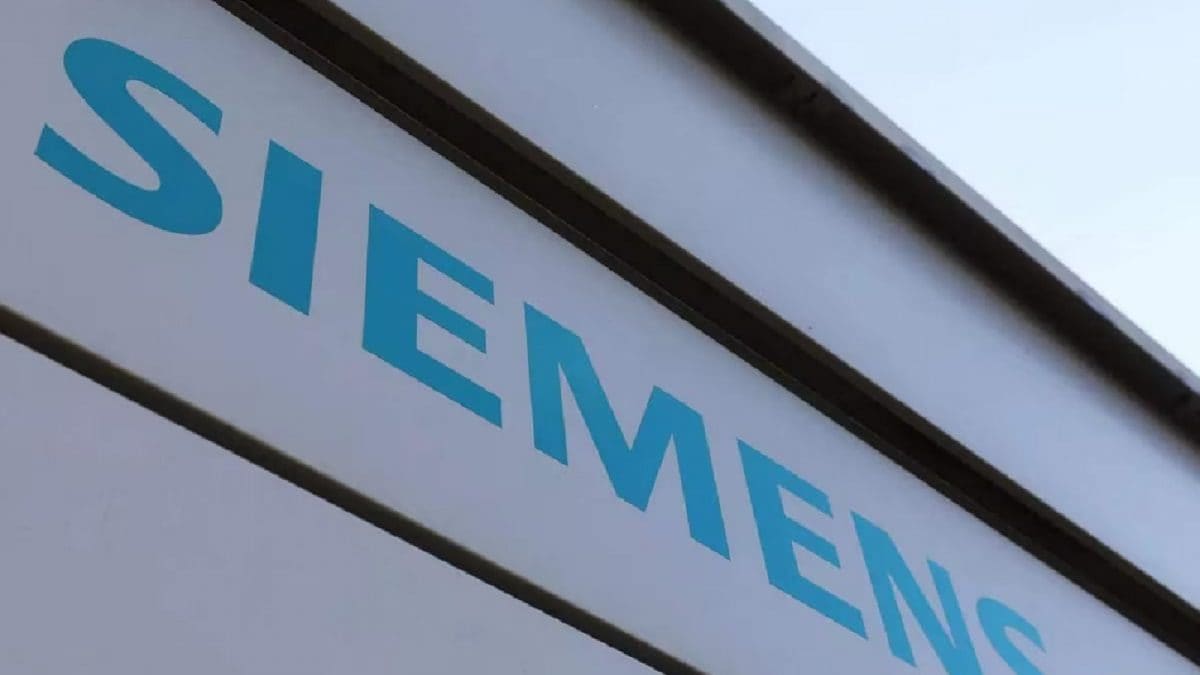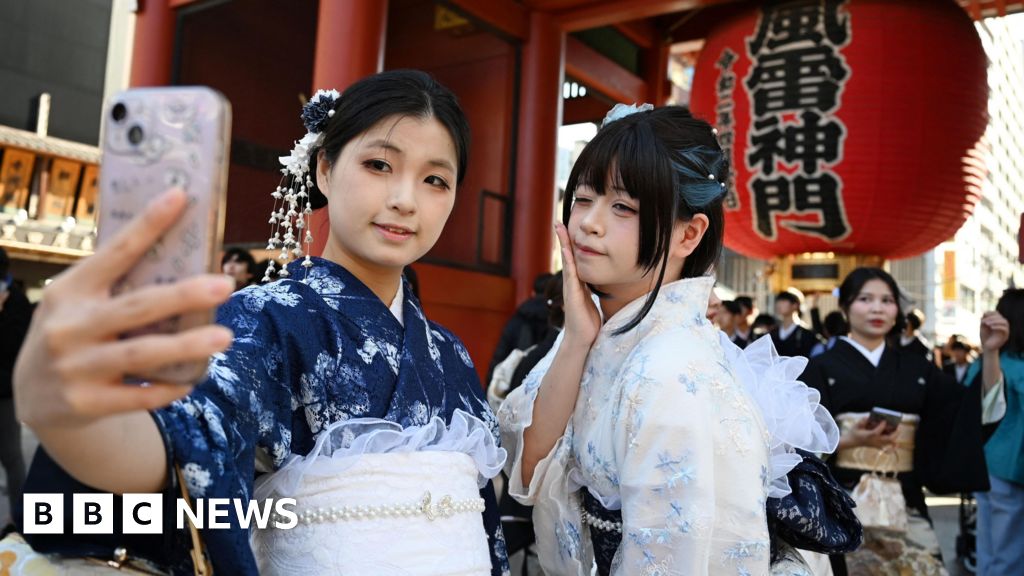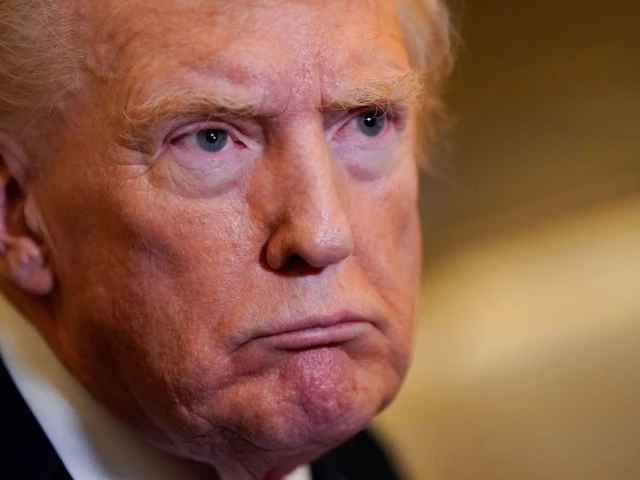Business
Who is winning global tech race? | The Express Tribune
1724844288-0/BeFunky-collage]_______-(8)1724844288-0-640x480.webp)
The Global AI Summit kicks off at the Saudi capital Riyadh, September 13, 2022. PHOTO:Twitter Al Arabiya
KARACHI:
“China is going to win the AI race.” The remark sent ripples through Silicon Valley and beyond when Jensen Huang, CEO of US chipmaking giant Nvidia, made it at an AI summit in London earlier this month. Huang, whose company dominates the global AI chip market, later softened his position, saying China is merely “nanoseconds behind America.”
But Greg Slabaugh, Professor of Computer Vision and AI at Queen Mary University of London, is convinced that China has “already won” the AI race. And he made a startling revelation to back up his claim: of all the papers presented at the 2025 International Conference on Computer Vision in Hawaii, half were authored by Chinese researchers – far outstripping the US at 17%. Factor in Chinese nationals working abroad, and the gap would widen even further.
Three years before Huang’s candid acknowledgement, the Australian Strategic Policy Institute had reported that China leads in 57 out of 64 critical technologies – from quantum sensors and AI to robotics and semiconductors – while the US maintains an edge in far fewer areas, such as biotechnology and aerospace. This marks a dramatic reversal from 2003 to 2007, when the US led in 60 of 64 technologies and China in just three. Beijing’s current dominance stems from a high-impact research ecosystem in which, in some fields, it holds something close to a near-monopoly.
This meteoric rise, especially in AI, couldn’t be stymied by US efforts to limit China’s access to advanced chips and manufacturing equipment, which were intended to maintain America’s edge in the sector. Unlike past advantages based on cheap labour or scale, China’s AI lead is structural, built on concerted strategy, coordinated investment, and an energy ecosystem optimised for massive computational growth.
The AI revolution is, at its core, a revolution of power – in both senses of the word. Training the largest data models requires a huge computing capacity, which is powered by electricity on a colossal scale. By the decade’s end, experts say, AI data centres could consume more power than some mid-sized nations. And China holds a decisive edge in this high-voltage contest. Its subsidised electricity, flexible regulation, and capacity to execute large-scale projects at rapid speed have led to the mushrooming of AI infrastructure nationwide. From data-centre clusters in Inner Mongolia to renewable-powered server farms in Sichuan, Beijing has built an energy foundation capable of sustaining AI’s exponential growth. On the contrary, US tech giants are increasingly hamstrung by a growing web of constraints. The American electricity grid is old and fragmented, creating logistical and regulatory bottlenecks. Microsoft has conceded that energy shortages are slowing the expansion of its data centre. Chinese authorities, meanwhile, have turned energy planning into a national security priority – integrating AI, cloud computing, and grid modernisation into one strategic blueprint.
While Western firms like OpenAI and Anthropic pursue closed, commercial AI models, Chinese developers have doubled down on open-weight systems – models whose trained parameters are freely available. The result has been an open-source explosion that is transforming global software development. Chinese open-source AI downloads have now surpassed those from the US, according to venture capital firm a16z. Companies such as DeepSeek, MiniMax, Z.ai, and Moonshot are releasing high-performance models at a fraction of US prices.
China’s innovation often lies not in raw capability, but in accessibility and cost efficiency. Airbnb CEO Brian Chesky recently revealed that his company had replaced OpenAI’s ChatGPT with Alibaba’s Qwen model, calling it “fast and cheap.” Chamath Palihapitiya, CEO of Social Capital, said his firm has switched to Moonshot’s Kimi K2, describing it as “way more performant” than American rivals.
Conflicting approaches are at play here. The United States, by its own admission, wants to maintain global leadership in AI to secure its economic competitiveness. China, on the other hand, pushes for democratisation of AI, promoting open cooperation, capacity building for developing nations, and an “AI for the public good.” With this approach, Beijing has flipped one of Washington’s strategic levers. American export controls – meant to slow Chinese progress by denying access to cutting-edge chips – have instead spurred Chinese firms to build leaner models that run on older hardware. “They’ve actually encouraged Chinese companies to be more resourceful,” said AI researcher Toby Walsh. “It’s exactly what happened with solar panels – constraints made them smarter and cheaper.”
The story doesn’t end there. One of the most consequential areas of Chinese dominance is remote sensing: the science of gathering data from a distance through satellites, drones, and advanced sensors. A recent global analysis of 126,000 peer-reviewed papers found that China produced nearly 47% of all remote sensing research between 2021 and 2023. The American share, which stood at 88% during the Cold War, has fallen to just 9%. The patent landscape tells the same story. Among the top 19 global patent filers in remote sensing between 2021 and 2023, Chinese institutions accounted for 62%. Why does this matter? Because remote sensing underpins nearly every next-gen technology – from self-driving cars and smart cities to climate modeling and precision agriculture. Whoever controls the sensors, data flows, and analytic algorithms effectively controls the informational foundation of modern economies.
That said, China’s leap was no accident. Since the early 2000s, Beijing has strategically targeted the field for heavy investment under national programmes like the “973 Plan,” pairing state funding with private enterprise. The result: a vast ecosystem of universities, startups, and ministries working in concert. The US, by contrast, has relied heavily on NASA and the private sector. But fragmented research funding, bureaucratic inertia, and inconsistent industrial policy have eroded its early lead. When one country produces nearly half of global output in a strategic domain, and controls most patents and funding, it is shaping the next generation of value chains.
China’s stratospheric rise extends far beyond data and algorithms. In sector after sector, Western companies find themselves being out-produced, out-priced, and out-innovated. In automobiles, Chinese brands are redefining global competition. In 2024, Chinese carmakers captured 7.4% of all passenger car sales in Europe, nearly doubling their share within a year. EV maker Leapmotor posted a staggering 7,000% jump in sales, while BYD and Chery continue their European expansion with EVs far more affordable than Western models. This is why Ford CEO Jim Farley recently issued a blunt warning: “They have enough production capacity in China to serve the entire North American market.”
The same dynamic plays out in wind power, where Chinese manufacturers like Goldwind, Envision, and Mingyang now occupy the top four global slots – pushing Western rivals Siemens Energy, GE, and Vestas down the rankings. Chinese turbines are up to 50% cheaper, thanks to economies of scale and domestic demand that dwarfs anything in Europe or the US.
Having said that, all is not lost for the West, particularly the US, which still dominates the premium end of AI, biotechnology, and aerospace. Yet Washington must rethink its approach: instead of trying to slow China’s rise through export controls and strategic containment, it should focus on large-scale investment in energy infrastructure, R&D, and education. At the same time, it needs to face the new reality.
The writer is an independent journalist with special interest in geoeconomics
Business
Siemens Surges Over 4% Despite Weak Q2 Results: Why Is Stock Price Rising Today?

Last Updated:
Shares of Siemens on Monday surge by over 4.3% to trade at Rs 3,218.10 apiece on the NSE despite a 7% y-o-y decline in consolidated net profit to Rs 485 crore in Q2.

Siemens Share Price.
Siemens Share Price Today: Shares of Siemens on Monday surged by over 4.3% to trade at Rs 3,218.10 apiece on the NSE despite weak Q2 results. The heavy electrical equipment maker has reported a 7 per cent year-on-year (y-o-y) decline in consolidated net profit to Rs 485 crore for the quarter ended September 30, 2025.
On the BSE, the stock traded at Rs 3,220.85 apiece as of 1:10 pm, which is nearly 4.5% higher than the previous close of Rs 3,082.95.
Siemens’ net profit (or profit after tax) had stood at Rs 523 crore in the July-September period a year ago.
However, the company saw its revenue from operations grow 16 per cent to Rs 5,171 crore during the quarter under review from Rs 4,457 crore in the year- ago period.
Siemens MD and CEO Sunil Mathur said, “We delivered a robust performance this quarter, with a surge in revenue, driven by strong performance in our mobility and smart infrastructure businesses while digital Industries volumes were impacted due to a lower reach in the order backlog from the previous year and muted private sector capex.”
He added that the profit was impacted by a one-time gain of Rs 69 crore from the sale of property in Q4 FY 2024. On August 8, 2025, the board approved changing the company’s financial year from October-September to April-March.
The current financial year is changed to October 1, 2024-March 31, 2026 (18 months). Thereafter, the financial year will be April 1 to March 31, every year.
What Brokerages Say
JM Financials in its note said Siemens’ revenue exceeded its estimates by 8%. However, its EBITDA beat was smaller at 5% on demerger-linked costs. PAT beat was a modest 2% on higher tax and lower other income. Order inflows continue to be robust relative to peer ABB India at 10% though missed our estimate by 5%.
“We resume with ADD as we value the stock at similar multiples to ABB at 50x P/E Sep-27 as Digital Industries (DI) margin challenge still persist. We note change on FY end to March end vs Sep earlier makes direct comparison superfluous for FY26E numbers,” JM Financial said.
Motilal Oswal has maintained its ‘Neutral’ stance on the stock, saying it wants to see a more broad-based ramp-up in scale before turning more positive. The firm noted that its current forecasts already bake in margin gains across divisions. It expects the smart infrastructure vertical to continue delivering strong growth, with a gradual pickup likely in the digital industries and mobility businesses as well.
Antique Stock Broking highlighted how Siemens has consistently reshaped its business model, moving away from being a pure industrial products player to becoming a technology-driven company aligned with investment themes across industry, infrastructure and transportation. The brokerage believes Siemens is well-positioned to ride the country’s ongoing capital expenditure cycle.

Haris is Deputy News Editor (Business) at news18.com. He writes on various issues related to personal finance, markets, economy and companies. Having over a decade of experience in financial journalism, Haris h…Read More
Haris is Deputy News Editor (Business) at news18.com. He writes on various issues related to personal finance, markets, economy and companies. Having over a decade of experience in financial journalism, Haris h… Read More
November 17, 2025, 13:18 IST
Read More
Business
Sheffield breakfast club for parents helps with high cost of food

Lucy AshtonSouth Yorkshire political reporter
 BBC
BBCDawn Hayes is cooking sausages and hash browns in the kitchen of Shirecliffe Community Centre in Sheffield.
She is helping out at an adult breakfast club where parents and grandparents who have children at the adjoining Meadows nursery can have a hot meal for £1.
“It stops a lot of people going home and being lonely and it makes sure single parents get a meal,” she says.
The club is unusual in catering for adults at a time when many families are struggling with the cost of food – and parents may go without full meals to ensure their children are fed.

Ms Hayes, 47, explains: “I originally started coming to the centre when I brought my daughter to the nursery. When we looked at what people wanted within the community, we decided to set up a breakfast club.
“As parents drop off their children, we decided they needed somewhere to go rather than just going straight home.”
She has been the cook since it began and says it was set up to provide both food and company.
“It stops a lot of people from going home and just being alone. There are a lot of single parents around here and as a single parent, you often don’t get time to eat for yourself as you get up, get the kids ready and give them breakfast.
“We’re a bit of a social activity but we also make sure parents are eating as well.”
Parents can have a breakfast butty, along with hot drinks and cereal. A nearby Tesco store donates tea and coffee but the club does not receive any grants. It relies on occasional community events for fundraising and on the £1 contributions.
Many schools and nurseries now operate breakfast clubs for pupils, often with sponsorship from the major supermarket chains and brands.
The government has also launched an “early adopter” scheme for 750 schools, which will be given funding to offer free breakfast clubs lasting 30 minutes.
Lina, 34, has three children. Her two eldest boys were born during the pandemic so she struggled to meet other parents when playgroups were closed.
“I was feeling so lonely with nobody to speak to, and trying to deal with my two little boys, but the breakfast club gave me chance to build my confidence and make friends.
“The hot meal is a bonus for everyone. When it’s Thursday, I know I’m going to have my coffee and breakfast and it’s like a treat.
“I don’t have the chance to go to cafes because of the cost and also because the kids will be crying, but I know all these people, they are my friends. We are not just a breakfast club, not even a community, we are a family now.”
Jane Clark, 61, is a grandmother now but also enjoys the club.
“I’ve got a lot of time on my hands now and I like having a chat with people, learning stuff from them and maybe them learning stuff from me,” she says, nursing a cup of tea.
“Being around children keeps you young. Happy kids, happy mums, happy grannies!”
Business
Japan tourism and retail stocks slide after China row

Japanese tourism and retail stocks fell on Monday after China warned its citizens not to travel to the country as Tokyo and Beijing remain locked in a row over Taiwan.
Japan’s Prime Minister Sanae Takaichi, who has been a vocal critic of China and its military activities in the region, suggested this month Tokyo could take military action if Beijing attacked Taiwan.
Shares in cosmetics company Shiseido plunged nearly 10% while department store chain Takashimaya and the owner of global fashion chain Uniqlo fell more than 5% in early trading.
China has consistently ranked among the top sources of tourists visiting Japan.
The share price falls came after the dispute between Beijing and Tokyo has deepened in recent days.
On Sunday, the Chinese government urged its citizens to reconsider studying in Japan, citing risks to their safety and a rise in crimes targeting Chinese people.
China’s Education Ministry also told students already based in Japan to closely monitor the security situation.
Last year, more than 100,000 Chinese students were enrolled in educational institutions in Japan, according to a Japanese government survey.
Also over the weekend, Chinese airlines – including China Southern Airlines, China Eastern Airlines, and Air China – offered refunds for flights to Japan.
Takaichi said in the Japanese parliament on 7 November: “If there are battleships and the use of force, no matter how you think about it, it could constitute a survival-threatening situation.”
A “survival-threatening situation” is a legal term under Japan’s 2015 security law, referring to when an armed attack on its allies presents an existential threat to Tokyo.
In such a situation, Japan’s self-defence forces can be called upon to respond to the threat.
Taiwan lies around 100km (60 miles) south of the closest Japanese island.
Beijing sees Taiwan as a breakaway province that will, eventually, be part of the country, and has not ruled out the use of force to achieve this.
But many Taiwanese consider themselves to be part of a separate nation – although most are in favour of maintaining the status quo where Taiwan neither declares independence from China nor unites with it.
-

 Entertainment1 week ago
Entertainment1 week agoChina unveils£5.4 bn Fujian, its most advanced aircraft carrier yet
-

 Tech7 days ago
Tech7 days agoFrom waste to asset: Turning ethanol production CO₂ into jet fuel
-

 Tech2 days ago
Tech2 days agoNew carbon capture method uses water and pressure to remove CO₂ from emissions at half current costs
-

 Politics3 days ago
Politics3 days agoBritish-Pakistani honoured for transforming UK halal meat industry
-

 Sports1 day ago
Sports1 day agoTexas A&M officer scolds South Carolina wide receiver after touchdown; department speaks out
-
Sports1 week ago
College football winners and losers: The catch of the year saves Indiana
-

 Business1 week ago
Business1 week agoMore than 1,000 flights cancelled as US air traffic cuts enter second day
-
Sports1 week ago
The next Tom Brady? No, Drake Maye is a different breed.













